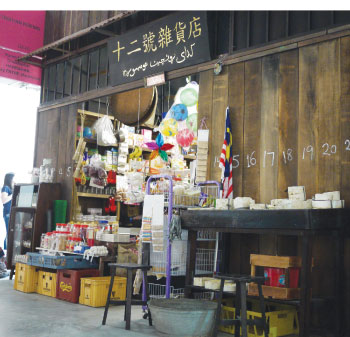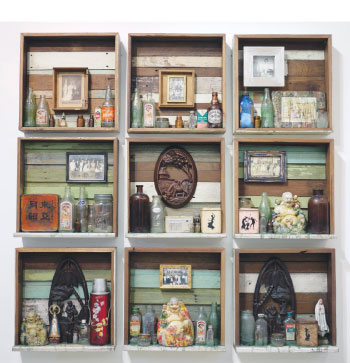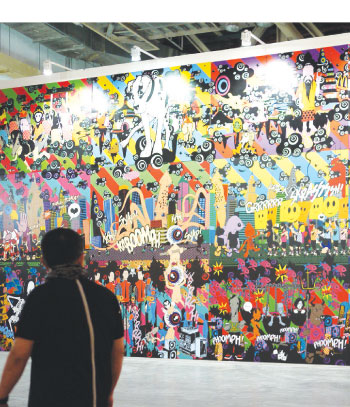New Straits Times, 29 January 2011
Art: Instant Museum
by Rachel Jena

12’s Kedai Runcit was an arresting piece, featuring works by Rozana Musa, Izat Arif, and Haslin Ismail

Norberto Roldan’s works at TAKSU drew together personal narratives and real objects belonging to his family
The inaugural Art Stage Singapore has been described as a meeting place and Malaysian art practitioners and enthusiasts were there in force, writes RACHEL JENA
HELD from Jan 12-15, the inaugural Art Stage Singapore heralded itself as Asia Pacific’s new international modern and contemporary art fair.
I attended Art Stage Singapore on day two and, after navigating what seemed like endless rows of booths at the Marina Bay Sands conference hall, I found myself at booth D4-04, where Wei-Ling Gallery (WLG) had set up shop.
It was a replica of its hub in Brickfields, Kuala Lumpur with its carpets and old coffee-shop-style chairs but, on the walls, Ivan Lam’s huge paintings took centre stage. Large, glossy images produced with Lam’s signature household paint came alive with instructions for viewers and a video of Lam explaining his works. I was pleased to see the artist himself at the booth.
He told me how Takashi Murakami had made an appearance, with an entourage, at the fair’s VIP preview the previous evening and how he was chuffed that the Japanese artist went to WLG’s booth to see his works. Like his physical works, Lam’s words painted a nice picture.
Lam’s privilege as one of only two Malaysian artists to get their own space (the other being Chris Chong at Valentine Willie Fine Art) was not coincidental. Gallery director Lim Wei-Ling informed me that the decision to feature Lam was made by Art Stage organisers, who after reviewing the gallery’s proposal, decided upon a solo feature.
It’s illustrative of Lorenzo Rudolf’s direction for Art Stage. As the former director to Art Basel, creator of Art Basel in Miami Beach, and the co-creator of ShContemporary in Shanghai, Rudolf also played the role of director at this fair and advocated a rigid selection process. Exhibitors and their booths’ content were scrutinised and while this seems uncompromising, it is a tactic that guaranteed high standards.
For Lim, this quality control was important, and by bringing in the right names — and there were many such as Ai Wei Wei, Damien Hirst, and Anish Kapoor — she argued, a certain buzz was created. “We have been to fairs where there really is no one,” she explained.
Still, it was tricky working with such specificity. “As a gallery owner, you do want to give an overview (of all your artists), but I can understand where the organisers are coming from with respect to showing a more curated, tighter solo exhibition,” said Lim.
Taksu faced a similar fate. “Actually eight of our artists were selected in the first and second round, but in the third round, Rudolf decided that Norberto (Roldan) should do a solo,” explained Taksu director Suherwan Abu.
No stranger to art fairs with a decade of experience, Suherwan says Art Stage has attracted serious collectors, “genuine, real, knowledgeable collectors”, who aren’t just there to speculate.
“I have Japanese and Singaporean institutions that are interested and art consultants here to collect artworks for their clients,” he said of the enthusiasm for Noldan’s beautiful assemblages that wove in personal narratives with actual objects from his family heirlooms.
While the opportunity to feature more artists didn’t materialise for Taksu, Art Stage organisers did propose an opportunity to work on a fringe show, resulting in an exhibition called Rogue Wave at Taksu Singapore with Malaysian artists such as Umibaizurah Mahir, Justin Lim, and Samsudin Wahab.
From this, it’s clear that Taksu’s presence in Singapore played a vital role for both the gallery and its Malaysian artists. Art Stage wasn’t a standalone event, but one enhanced by auxiliary programmes and this is a feature that could be capitalised upon in next year’s fair, which has already been scheduled for Jan 12-15.
Richard Koh of Richard Koh Fine Art (RKFA) may certainly be heading down this route. After all, he opened his gallery on the island during this year’s fair and was impressed by the turnout at the opening.
“It was very good,” he said. “We had standing room only all the way out to the street. It was quite amazing.”
Koh’s booth featured some of the region’s best, including our own Nadiah Bamadhaj, although it was Natee Utarit’s works that stood out. Set against grey walls, the Thai artist’s works were displayed like masterpieces in a museum with the epic painting, The Birth Of Tragedy, even cordoned by red rope. Next to this painting’s label was a conspicuous red dot indicating its status: Sold.
In fact, what was apparent at RKFA space were the many red dots on works. Success was palpable here and while Koh admits that many purchases were by existing collectors, he argued that Art Stage – the island’s second fair after ARTSingapore — has the potential to spark interest among new clientele for contemporary Southeast Asian art.
He noted how luminary collectors such as the Rubells of Miami had wandered through RKFA’s booth and how this preliminary interest could lead to higher demand for our region’s contemporary artworks.
Koh also had a Project Booth, a special platform for curated works, where he presented Letters From Songkhla by Kedsuda Loogthong, an intimate work based on correspondences between the Thai artist and her family. I played devil’s advocate and asked Koh why a Malaysian artist wasn’t in that prized spot. Koh recounted how he’d approached five young Malaysian artists to produce works for Art Stage, but that none took him up on the offer, citing various reasons.
A missed opportunity, as the work by the 20-something-year-old Thai artist was scooped up by a regional art museum.
Valentine Willie Fine Art (VWFA) showcased delights from its fine stable of regional artists. It featured five of Southeast Asia’s most prominent female artists — Amanda Heng, Geraldine Javier, Mella Jaarsma, Nona Garcia, Simryn Gill — in its main booth. Photographic and video documentations of Melati Suryodarmo’s performances were exhibited across the hallway, whilst Malaysian artist Chris Chong occupied his own Project Booth with Block B, his video depicting the lives of an expatriate Indian community in Brickfields.
Dionne Ng of VWFA said the exhibits at its three spaces, the largest output by a local gallery, was “true” to their focus as a gallery, and so, ending my Malaysian gallery tour here seemed apt. A big name encapsulating some of our region’s best, it was essentially a condensed version of what attracted people to art fairs in the first place.
Around the fair, Japanese artist Takashi Kuribayashi constructed a soaring paper forest, Chris Levine’s 3-D light portrait of Queen Elizabeth II flashed ominously, and T Venkanna performing in the nude, offering his hand to visitors who would then have their portrait taken with the artist (I later found out this performance was pulled out as nudity is illegal in Singapore).
With such mind-blowing volume and variety, it’s easy to blend in, and without an entourage like Murakami’s, it’s easy to get lost in the crowd. Is it too early to envisage a day when contemporary Malaysian art has its day?
Perhaps not, as 12 proved in its Project Booth, where they featured an authentic reconstruction of a kedai runcit. It delivered artistic merit and cultural prowess, dug deep into the memory boxes of its visitors, and balanced the artworks of newcomers Rozana Musa, Izat Arif, and Haslin Ismail against highly relatable objects. It was, in short, memorable and different.
I agree with comments made by Malaysian gallerists. Suherwan told me how important it was to think big (“Malaysia has to think global, not just domestic”), and Lim made an observation of the collapsing borders in contemporary art (“It’s not just contemporary Indian and Chinese anymore”) that’s only accentuated by art fairs such as Art Stage and our presence there.
What struck the biggest chord, however, was Rudolf’s words in the fair’s catalogue: “Art Stage Singapore is a meeting place, it’s a show, a market place, an ‘instant’ museum, and much more”.
It was the perfect summary of the event, as I myself witnessed how many Malaysian art practitioners and enthusiasts had made it across the border to show their support. There were Malaysian artists sitting at gallery booths discussing the event, copies of sentAp!, Malaysian’s own art journal, being disseminated by its founder Nur Hanim Khairuddin, and above all, I heard whispers that many more Malaysian visitors were expected to turn up before the fair’s final day.
More than a fair, it’s safe to say that Art Stage Singapore was a great experience.



